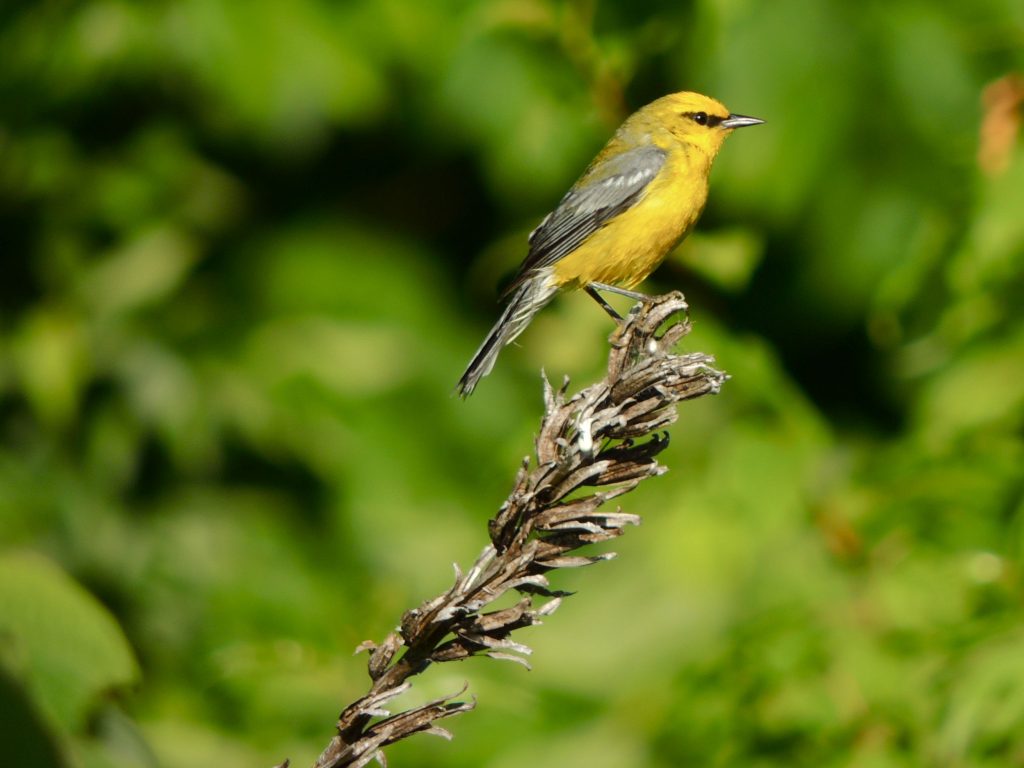June 24 2016. Guelph Line, Milton, ON. The day is only half done as I write this but so far three significant events have unfolded: Britain has voted to leave the EU, the ramifications of which are almost beyond my pondering; This is the last day of school for Ontario kids – happy laughter next door; And I found lots of interesting birds, Blue-winged Warblers included.
I woke early and decided to visit a nearby forest that has a reputation for good birding. I’d read many list-serve reports about this place and some of notable birds to be seen, I’m generally not one to go chasing the latest hot-spot but the night had been cool and the prospect of a low mosquito count helped tip the balance.

My first encounter was a nice little Least Flycatcher, it must have had a nest nearby as it was quite concerned with my presence, chipping and flittering around, so I soon moved along; besides I could hear, loud and clear, the breathy, inhale-exhale, ‘ bzzzzz – bzzzzz ’ song of a Blue-winged Warbler. Loud and clear!, I was quite startled, very close and there it was again! Maybe my hearing is not as bad as I’d come to suppose.
But just around the corner were two early risers staring intently at a nearby thicket, they crouched behind cameras, colossal-lensed and tripodded, . The Blue-winged song came from them: full volume and repeated at one-second intervals from some kind of playback set up. I felt a little cheated and quite a bit of sympathy for any Blue-winged Warblers in the immediate area who might be bemused, confused or agitated by the falsehood. I stood beside the photographers with deep unease rising inside me.
There is little in the way of organizational structure or authority among birders, it’s a pastime for most of us, no more than that. But there are codes of ethics and one of the tenets is that you reject or at least minimize the use of recordings as lures, especially during breeding season; they’re seen as potentially disruptive and might expose a bird or its nest to needless competition or predation.
There exists an air of suspicion and antipathy between purist birders and purist bird photographers over this topic. Much has been written on the matter, a lot of it on-line and very heated. I’m sure they’re decent guys but I disliked the approach these two gentlemen were taking to finding and photographing birds today; I walked on.

It was, as anticipated, a very bird-rich area. In the heard-but-not-seen category were Red-eyed and Yellow-throated Vireos, Pileated Woodpecker, Eastern Peewee, Wood Thrush, Mourning Warbler and House Wren; all nice birds. But even better were the seen-and-heards: Common Yellowthroat, American Redstarts, Veery, Eastern Kingbird and (Bird of the Day) Blue-winged Warblers. I heard this Blue-winged Warbler long before I saw it but to my delight, rather than evade me, it came close to size me up and allowed me to get a couple of quick fire photos. (This species by the way is the other half of the Golden-winged Warbler genetic-swamping story that I wrote about just a few days ago.)
I’m sure those two highly equipped photographers got some great photos, they deserve some reward for lugging all that stuff around. But then I didn’t do too badly with my little point-and-shoot either.